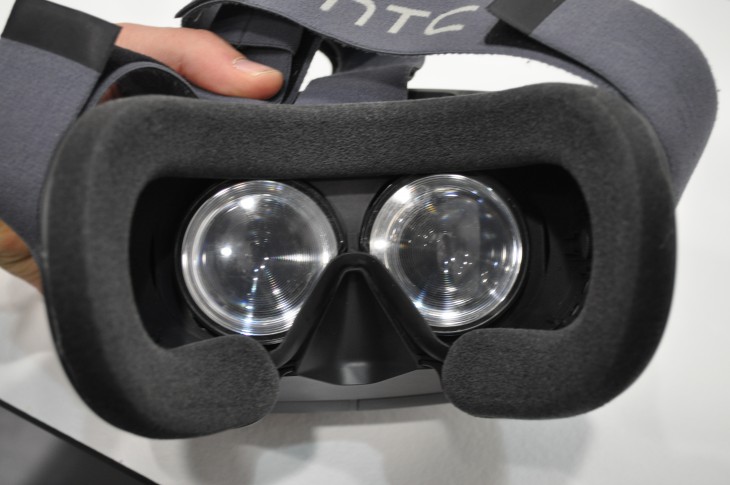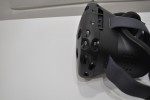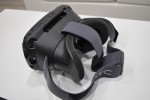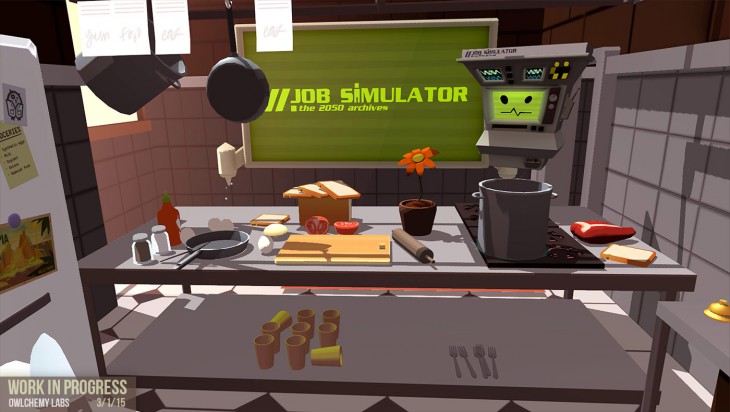
HTC held what will most likely be their biggest event this year at Mobile World Congress, they announced their latest flagship smartphone, the HTC One M9, their fitness band, the HTC Grip and then surprised just about everyone by announcing a move into Virtual Reality space, announcing a VR Headset called the HTC Vive, powered by Valve’s Steam VR platform.
The Vive is a product still somewhat shrouded in mystery. It’s still being worked on at the moment, with a full developer program due to kick off this Spring (in the US, Autumn in Australia) to seed HTC Vive Developer Edition hardware to eager software developers ahead of the release of the HTC Vive Consumer edition before the end of the year.
The Hardware
The unit currently being shown is early stages, it’s a full PC setup with a headset, two hand controllers – currently wired, but will be wireless when the consumer version launches – two room sensors and of course the PC that runs the system.
Controls
The controllers consist of two nicely formed joysticks, which appears to be an upside down ski stock, without the prong rising above the pommel. There’s a trigger grip for your index fingers and a circular jog-dial you can rotate with your thumbs – the triggers and jog dials are how you will select, use and interact with virtual items ‘in-game’.
Headset
The headset is, as you would expect mounted on your head like you would put a scuba mask on. The headset is comfortable due to luxuriously thick foam padding around the face mask, and the headset hangs over your head using a thick elastic strap that sits quite comfortably, it’s also relatively light considering the size and components inside it. It’s comforatble enough that you could see yourself wearing this for quite a long time – and once you’ve experienced the demos you’ll want to wear it for a long time.
On the front of the headset are what appear to be reflectors which are most likely used by the three dimensional mapping and tracking sensors that are placed at two points around the room, though I’m pretty sure that when I was in-game I at some point turned away from them and the tracking didn’t skip a beat.
The display on the HTC Vive is I was told around 1200×1080 and it’s pretty good, though not perfect. You can still see sub-pixels due to the proximity of the screen to your eyes, but the experience is the selling point here and HTC hasn’t actually released the Consumer Edition yet – that will come by the end of the year – so it may be a different screen by then.
At the top of the headset is where the HDMI, USB and the sound channel comes out. At this stage the sound comes through a set of headphones connected separately but this will likely change before the consumer launch. It adds to the cable bundle but not overly so.
Cables
The line of cables tethering you to the Vive is fairly extensive due to the controllers being wired and that requirement will drop by consumer launch. There’s a waist strap that keeps the cables in theory from getting you tangled – but I seemed to get entangled in them at least once in the 15 minute demo I had.
Tracking and Room Mapping
The HTC Vive needs a clear area for you to work/play in – I was told around 3 metres by 4 metres is about the minimum area. The room sensors which you should mount on top of a bookshelf or some other shelf will then map your room to fix boundaries in your virtual space.
The mapping is really good – or was in the demo, which was a blank room, but HTC seem confident that this will work well in a real-world environment. As you approach the physical walls in the virtual world a grid pattern rises up in your virtual world, if you approach fast the grid rises quickly, slow and it’s slow to rise – the virtual tracking is that good.
The mapping will also take into account lounge settings as your virtual ‘wall’ but you’ll still need a clear area, so you can’t leave a coffee table in the middle of your room.
The Vive headset is wired – and apparently will be at least for this version of the HTC Vive, mainly due to the huge amount of data passing from the computer to the Vive. Being tethered to a PC via a headset though, is a small price to pay for what I was about to experience.
If you’ve played VR games before, chances are you’re familiar with Dactyl Nightmare – one of the first VR games that most people think of when they hear about VR gaming. Rest assured, comparing Dactyl Nightmare to HTC Vive is like comparing a child’s tricycle to an Advanced Jet Fighter – the HTC Vive is light years ahead.

The end result of all this is that the room mapping and the tracking of the headset works. You feel comfortable, and even with the cable tether, you can sense where the cable bundle is and untangle yourself without being taken too much out of the virtual world.
Demos
Reception and Induction
The demo we were given involved a short learning curve – the entry room, is a grey space with floating icons for various game titles floating in the air. Your hand controllers are fairly well visualised in front of you.
The first introduction is using the controller to blow up a balloon, which you can then punch with your ‘fist’ – the Vive system is tracking the movements of your hands in-game – but it’s easy to forget and think it’s tracking you.
After getting to grips (hah) with the hand controls, you then begin learning to walk. As you walk around in the virtual world, a series of polygons move out of your way till you approach a wall, at which time it rises out of the ground as you get closer to the wall. When you’re within reach of the wall you reach out and touch it – the virtual wall marries up exactly where the physical wall exists; it’s kind of a weird, yet oddly safe feeling knowing that the game has your virtual back.
Once you’re comfortable navigating it’s time for the software demonstration. The Vive has some demos ready for show, although at least one had no interaction and was merely and experience.
TheBluVR: Encounter by Wemo Labs
First up, you find yourself underwater on a sunken ship. A school of small fish is swimming about, you can wave your hand at them and they swim away, or you can try to punch them. There’s a couple of Mantra Rays swimming by overhear and the shadows slide across you as they glide past.
Exploring the area, you walk over to the railing of the ship, where you look down and see a plane wreck sunk on a ledge beneath where the ship rests – you actually naturally bend over to look out. It’s that Full Room Scale experience that HTC spoke about and it’s so easily natural to do, you literally don’t even think about it, your mind is already along for the virtual ride.
Having experienced this feeling of depth, you turn around and are immediately dwarfed by a massive humpback whale who has swum up behind you and is investigating your presence.

The whale pulls up right near you and he’s close enough to touch. Your attention is drawn to that massive eye which sits right in front of you and the whale winks – it’s a head-rush, but at that point the first demo is over.
Job Simulator by Owlchemy
The next demo takes place in a kitchen. Your environment is fully interactive and you can use your hand controllers a lot more in this demo. The demo is actually for cooking, so you can pick up the various ingredients and implements around the kitchen and cook from a recipe, but where’s the fun in that? Pick up the plates and throw them, tomatoes, pots, pans whatever and throw them. The plates smash, the pans ding and that bottle of wine you threw a saucepan at? It smashed into multiple shards.
If on the other hand, virtual destruction isn’t your thing and you cooked a meal, you can deliver a plate of food to the window and ring the bell, at which point the plate fly’s off and we’re onto the next demo.
The Battle
Next up is a purely visual experience which gives you an idea of how VR can be used in a layered visual representation of a scene which can allow different perspectives – as well as showing off that Full Room Scale experience.
This demo was of a battle. Dotted around the landscape were soldiers shooting guns at a fortified battlement, with a tank rolling in, an airship floating in and you can move up and down physically to examine it all, turn around and move behind objects to get a different perspective. Eventually you’ll get right down to ground level, looking up at the high walls and you’ll find that as the scene is VR, you can even go beneath the ground surface – at which point you start discovering the skeletons buried beneath the surface.
The effect of the battle is quite stunning when you get down to ground level, between the soldiers charging into battle against heavy fire from the wall, the tracer fire from above and your perspective, about the only thing missing from the scene is the smoke and smell of cordite from the battlefield.
It’s about at this point, your brain takes a step back and reminds you, you’re in a blank room wearing a VR headset and you’ve just crouched down physically to get a better view in a virtual world; and you want more!
Aperture – Valve
VR has the potential benefit to be used for actual real world applications and the Robot Repair simulator from Valve is a great to demonstrate the potential for VR.
In this simulator you interact with a futuristic garage, there’s drawers full of plans, tools and parts. Once you’ve had a rifle through the drawers using the HTC Vive controllers you’re ready for your first robotic patient. You walk over to the door, throw the virtual switch with your controller and the door opens to what appears to be some sort of robot from the Portal universe.
I had a few problems with sound at this point but the experience itself was awesome. You need to use the controls to pull the robot apart, inspect it and then attempt repair. I sucked at robot repair – my robot fell apart after I hit the wrong control – and the narrator of the story took gleeful pleasure in telling me before dumping the expired unfortunate robot into the garbage which opens beneath you feet.
Painting with light
The last demo is painting with light – but it’s more than that and was without doubt the most creative and possibly fun to explore demos of the Vive. Think of it as photoshop or Paintshop writ large, extremely luminescent and colourful and in three dimensions. The painting with light demo is similar to the light paintings you’ve seen which are created by people using slow shutter speeds on a camera and a light source – but made simple.

Using your hand controls you spin the dial left to spin a cube which has various tools – Brush styles, Colour Wheel and other controls – while you use your right hand to gesture at the specific brush style, or colour on the colour wheel to use, all similar to how an artist uses a paintbrush on a palette.
Once you’ve selected the brush and colour you’re free to start painting. Swipe across the screen and then move and you can view the line in a three dimensional plane. You can add to this light painting or remove it, and start again and you can move around your drawings in 3D.
There’s all kinds of brushes from simple lines, to broad brushes, ink drops, flames (yes, they flame after you draw them) and even a rainbow you can splash across the canvas in a wide arc.
The light painting demo is loads of fun. Paired with a second headset, or connected to another HTC Vive user on the internet, you could perhaps play one of the most epic games of Pictionary ever; and it’s all within the realms of possibility with Valve and the Steam VR platform backing it.
Conclusion
Stunning, brilliant, dazzling, breath-taking, impressive, out of this world – all words and phrases I am pretty sure I used upon my exit back into the real world when describing the experience.
There’s a video in the hands of HTC at the moment filled with me just gushing about my experience with the HTC Vive – and I feel I have gushed here a little too, but it’s warranted, the HTC Vive is just that good.
The HTC Vive IS the future of VR, it is far and above functionally superior to every VR platform I have ever seen, or used – and I’ve used a fair number of those.
When I exited the demo room, if HTC had placed a demo kit in front of me for sale to take home that day – my credit card would be maxxed out and my wife would be ready to shoot me – but it would be worth it. If you have the opportunity to try the HTC Vive, you should, the Vive needs to be seen and experienced in person but once you try it, don’t blame me if you too want to pay any amount to get it into your life.











Now if only I could figure out how I’m going to set my rig up in a 3×4 room atleast….
It may be down to who can launch first now with so many players on the market. But they will need to have a ‘killer app’. Having Valve with this is a huge plus.
I was pretty sceptical of the free movement option when I first heard it but it appears you can set up your own boundary so this could be pretty cool.
The old Virtuality roadshow with Dactyl Nightmare used 3 Commodore Amigas. One for driving each gaming pod and a third as the network controller. I got to play it when it was at Australia Fair shopping centre in Southport in 1993.
The Vive looks like it it would be fun as is.
I like the idea of separate headphones, if you have decent gaming headphones or regular headphones, this will be a benefit, as the sound will be that much better.
What spec PC did they say you needed for properly running the setup?
Thanks for the review – totally excited by this whenever it turns up over here. It’s going to be very interesting to see how Oculus react and if they would be tempted to use the open source Lighthouse positional tracking system. Holodeck here we come!